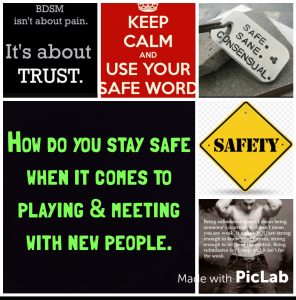What does red flags mean?
Red flags are warning signs that a potential partner may not be a safe person for you to play with. What is a red flag for one person, may not be a red flag for someone else; to a certain degree what constitutes a red flag can be somewhat personal.
Here is a list of some common red flags.
- Demanding straight off that you call him or her by certain titles.
- Saying you can’t have a safeword.
- Having you stop contact with family and/or friends.
- Collaring after a week or less . (This is classed as a velcro collar, A sub wanting a collar more than a bond or a Dom/me wanting to collar someone too quick normally means they are collector).
- They don’t care about your mental or emotional wellbeing.
- Anyone who says they have no limit or wants someone none.
- No aftercare by the dominant after a scene. (This can leave the sub feeling emotional, vulnerable and feel like they have failed).
- When a Dom/me says the word NO is not acceptable in any context.
- When a sub “tops from the bottom” without discussing it with the Dom/me first.
- Only communicates with you at strange hours and gets made if you try contacting them at other times.
- Criticises the local BDSM community, refuses to participate especially if they never were part of it.
- Consistently breaks promise.
- Always finds excuses for not meeting.
- Does not respect your limits, negotiations or contracts.
- Pushes you into a D/s relationship too fast.
- Falls in love you way too fast and swears undying love before even meeting you.
- Hides behind their D/s authority and says that their authority should not be questioned.
- Tries to make you feel guilty for not being good enough.
- Says they are a “true Dom/me, sub” or says that they are a “true Dom/me, sub”.
- Loses control of their emotions in arguments and resorts to yelling, name-calling and blaming you.
- Will not discuss what your possible future relationship could be like.
- Tries to keep you in the dark about what might happen next in the relationship.
- Does not respect your feelings, rights or opinions.
- Blames you for your hurt feelings.
- Is constantly asking for money from you.
- Threatens suicide or other forms of self-harm to get you to do what they want.
Trust your instincts, if you feel uncomfortable, pressured, overwhelmed in a negative way or just have a nagging gut feeling that something in not quite right. Then step back, take some times to consider what is causing you to feel this way, consider if this relationship is right for you. (Applies to D-types and s-types).
It’s okay to walk away. Don’t think you have failed or that this is not for you, sometimes things just don’t work out. Sometimes it may take you a little longer to spot a fake. Look after yourself you are important, your thoughts and feelings matter!
As always S.S.C, R.A.C.K, P.R.I.C.K.

